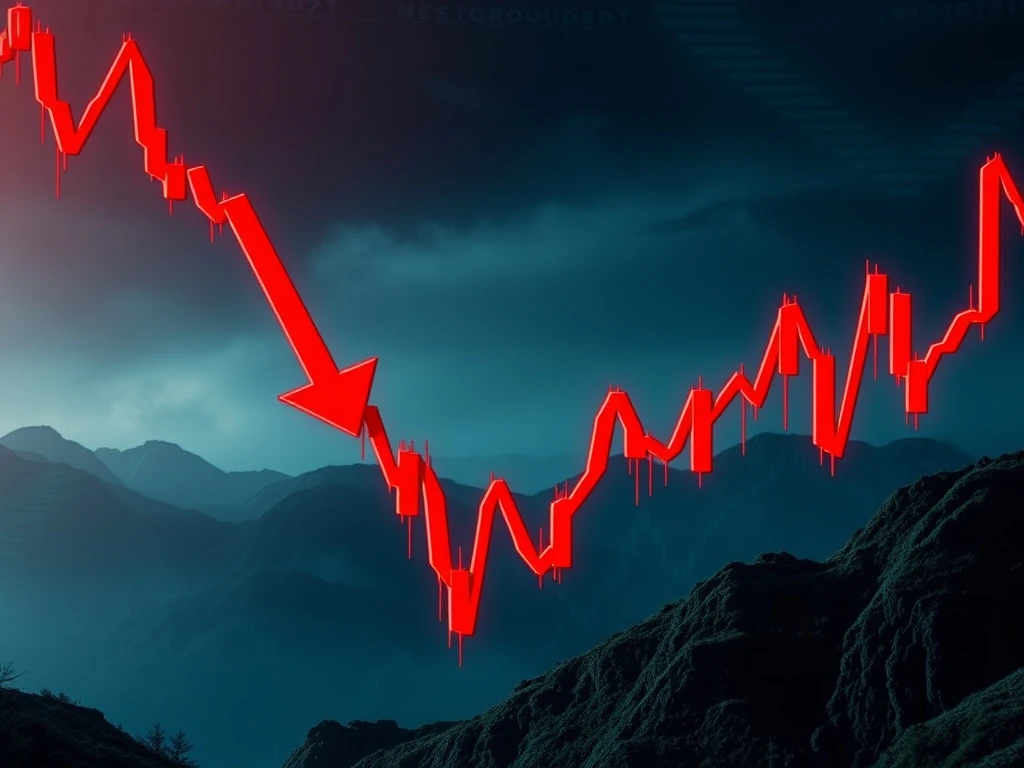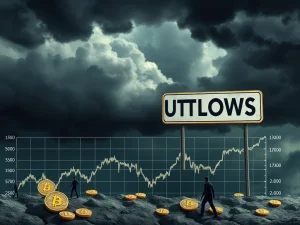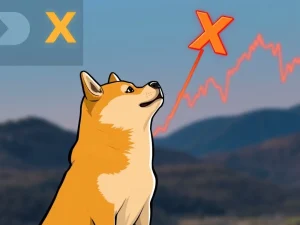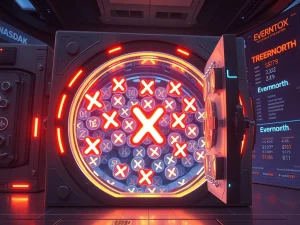Neiro Ethereum’s Alarming Plunge: A Deep Dive into NEIROUSDT Market Trends

The cryptocurrency market is renowned for its volatility, but for holders of Neiro Ethereum (NEIROUSDT), the past 24 hours have been particularly turbulent. As of July 25, 2025, this digital asset has experienced a significant downturn, raising concerns and prompting a thorough examination from traders and investors alike. This deep dive will unravel the recent price action, dissect key technical indicators, and offer crucial insights into what might lie ahead for NEIROUSDT.
Neiro Ethereum Faces Steep Decline: A Daily Snapshot
The latest market data paints a clear picture of a challenging period for Neiro Ethereum. Over the past 24 hours leading up to July 25, 2025, NEIROUSDT witnessed a notable fall of 10.8%, breaching a critical psychological support level at $0.0004500. This move signals strong bearish momentum, leaving many wondering about the immediate future of the token.
Let’s look at the key performance metrics from the 24-hour period ending 12:00 ET on July 25, 2025:
| Metric | Value |
|---|---|
| Opening Price (2025-07-24, 12:00 ET) | $0.00046440 |
| 24-Hour High | $0.00046809 |
| 24-Hour Low | $0.00043212 |
| Closing Price (2025-07-25, 12:00 ET) | $0.00045743 |
| Total 24-Hour Volume | ~19.5 billion tokens |
| Notional Turnover | $8.88 million |
The daily low of $0.00043212 represents a 6.8% drop from the previous day’s low, underscoring the severity of the decline. This level is now a critical near-term support to watch.
Decoding the NEIROUSDT Breakdown: What Happened?
The price action for NEIROUSDT over the last 24 hours clearly exhibited a strong bearish bias, marked by a decisive breakdown. At approximately 03:45 ET, a significant event unfolded: a bearish engulfing pattern formed. This candlestick pattern, where a large red (bearish) candle completely ‘engulfs’ the previous green (bullish) candle, is a powerful reversal signal, often indicating that sellers have overwhelmed buyers. In this instance, price dropped from $0.00044158 to $0.00043706, confirming the bearish breakdown below the $0.0004500 support.
Accompanying this price action was a substantial spike in trading volume. Over $1.99 billion tokens were traded at 03:45 ET, providing crucial confirmation of the bearish bias. High volume during a breakdown suggests strong conviction behind the move, reducing the likelihood of a false breakout.
While a doji candlestick formed at 06:00 ET, suggesting some short-term indecision between buyers and sellers, it did little to alter the overarching bearish trend. The overall market structure remained firmly under the control of sellers, pushing the price towards new lows.
Unpacking Bearish Trend Indicators
To gain a deeper understanding of Neiro Ethereum‘s current state, a closer look at key technical indicators is essential. These tools help traders identify patterns and predict future price movements.
Moving Averages: Signaling a Death Cross
Moving Averages (MAs) are widely used to identify trend direction. On the 15-minute chart, a ‘death cross’ formed early in the session as the 20-period MA crossed below the 50-period MA. A death cross is a bearish signal, indicating that short-term momentum is waning and a downtrend is likely to continue or strengthen. On the daily chart, the 50-period MA remained positioned above the 100- and 200-period MAs. This configuration further reinforces a longer-term bearish bias, suggesting that the asset has been under selling pressure for some time. Price closing below all three key moving averages is a strong indication that the downtrend is likely to persist.
MACD & RSI: Lack of Buying Interest
The Moving Average Convergence Divergence (MACD) and Relative Strength Index (RSI) are momentum oscillators that provide insights into the strength and speed of price changes.
- MACD: The MACD line remained consistently below the signal line throughout the session, which is a bearish signal. Furthermore, bearish divergence was observed, where the price made lower lows, but the MACD made higher lows (or less negative lows), indicating weakening selling momentum that often precedes a reversal. However, in this case, the sharp decline persisted, suggesting the divergence was overwhelmed by strong market sentiment. The MACD histogram showed increasing bearish momentum during the breakdown, validating the strength of the selling pressure.
- RSI: The Relative Strength Index plummeted to near oversold territory, hitting approximately 28 by 05:00 ET. Typically, an RSI below 30 suggests an asset is oversold and might be due for a bounce. However, the absence of a significant rebound in NEIROUSDT despite the oversold RSI indicates a severe lack of buying interest. For most of the session, the RSI remained below 50, which is generally considered a bearish zone, reinforcing the overall downtrend.
Bollinger Bands: Increased Volatility Confirmed
Bollinger Bands measure market volatility and identify overbought or oversold conditions. During the breakdown, the Bollinger Bands expanded significantly, with price falling below the lower band at 03:45 ET. This widening of the bands confirms a surge in volatility and suggests that the strong bearish move has significant momentum behind it. The fact that price remained below the 20-period moving average (the middle band) for most of the session further suggests that the downtrend remains intact. A contraction in the bands, which might signal a potential reversal or consolidation, was not observed, indicating sustained volatility and potential for continued price movement in the current direction.
Leveraging Technical Indicators for Informed Decisions
Understanding how volume and Fibonacci retracements interact with price action is crucial for making informed trading decisions, especially during a pronounced bearish trend.
Volume & Turnover: Confirming the Bearish Move
Volume is often called the ‘fuel’ of price movements. A high volume confirms the validity of a price move, while low volume can suggest a lack of conviction. The spike in volume to over 1.99 billion tokens traded at 03:45 ET, coinciding with the breakdown, provided strong confirmation of the bearish move. This high volume rules out the possibility of a ‘false break,’ where price temporarily moves past a level only to reverse quickly. Turnover, representing the total value of traded tokens ($8.88 million for the 24-hour period), also increased sharply during this period, further supporting the validity of the breakdown. The alignment of price and turnover during the breakdown suggests a well-confirmed move, and the absence of divergences in the volume profile indicates a consistent bearish scenario.
Fibonacci Retracements: Identifying Key Levels
Fibonacci retracement levels are horizontal lines that indicate where support and resistance are likely to occur. These levels are based on Fibonacci numbers and are widely used to identify potential reversal points or targets.
- 15-minute Chart: Applying Fibonacci retracements to the recent 15-minute swing from the high of $0.00046440 to the low of $0.00043212, Neiro Ethereum initially found some support at the 61.8% level, around $0.0004480. However, this support proved temporary. The 38.2% retracement level at $0.0004495 was briefly tested but ultimately failed to hold, reinforcing the bearish momentum.
- Daily Chart: On the daily timeframe, the 61.8% retracement level from the prior week’s high of $0.00046809 to the current low of $0.00043212 is situated at $0.0004513. This level could serve as a key point to watch for a potential bounce or, if broken, a confirmation of further downside.
Comprehensive Crypto Market Analysis: What’s Next for NEIROUSDT?
Given the strong bearish signals from various technical indicators, the immediate outlook for NEIROUSDT suggests continued pressure. Investors and traders should brace for the possibility of Neiro Ethereum testing the $0.0004400–$0.0004320 range in the next 24 hours. The $0.00043212 level, which marked the recent low, is a critical support. A decisive break below this point could open the door to further significant downside, potentially leading to new lows.
For those considering entering or exiting positions, caution is paramount. Volatility remains elevated, and the momentum is clearly bearish. While an oversold RSI might tempt some buyers, the lack of a bounce so far indicates that selling pressure is still dominant. A sustained rebound above the $0.0004500 level would be the first strong signal of a short-term reversal. However, confirmation through increased buying volume and a shift in technical indicators would be essential before any bullish sentiment can be established.
In this challenging environment, active risk management and careful monitoring of key price levels are crucial. Traders should consider setting stop-loss orders to mitigate potential losses and avoid trying to catch a falling knife without clear signs of reversal.
The recent performance of Neiro Ethereum highlights the inherent risks in the crypto market. While the asset has seen a significant downturn, the resilience of the broader crypto ecosystem means that opportunities may emerge for those who conduct thorough due diligence and apply sound trading strategies. Keep a close eye on the key support and resistance levels mentioned, as they will dictate the next moves for NEIROUSDT.
Frequently Asked Questions (FAQs)
Q1: What caused the recent price drop in Neiro Ethereum (NEIROUSDT)?
The recent 10.8% price drop in Neiro Ethereum (NEIROUSDT) was primarily driven by strong selling pressure, confirmed by a bearish engulfing pattern and a significant spike in trading volume. Technical indicators like the ‘death cross’ on moving averages and an oversold RSI without a bounce further solidified the bearish sentiment, indicating a lack of buying interest and a prevailing downtrend.
Q2: What does a ‘bearish engulfing pattern’ signify for NEIROUSDT?
A ‘bearish engulfing pattern’ is a strong candlestick reversal signal. It occurs when a large bearish (red) candle completely covers or ‘engulfs’ the previous bullish (green) candle. For NEIROUSDT, its formation at 03:45 ET signaled that sellers had decisively taken control from buyers, leading to a breakdown below key support levels and confirming a strong bearish bias.
Q3: How do Moving Averages and RSI indicate the bearish trend for Neiro Ethereum?
Moving Averages (MAs) indicated a bearish trend through a ‘death cross’ on the 15-minute chart (20-period MA crossing below 50-period MA) and price closing below all major daily MAs. The Relative Strength Index (RSI) hitting oversold levels (near 28) without a subsequent bounce, and remaining below 50 for most of the session, further confirmed the lack of buying interest and the strong bearish momentum in Neiro Ethereum.
Q4: What are the critical price levels to watch for NEIROUSDT in the short term?
In the short term, traders should closely monitor the $0.0004400–$0.0004320 range. The recent low of $0.00043212 is a crucial support level. If this level breaks, NEIROUSDT could face further downside. Conversely, a sustained rebound and close above $0.0004500 would be necessary to signal a potential short-term reversal, though confirmation from other indicators would still be needed.
Q5: Why is volume important in confirming a price breakdown for NEIROUSDT?
Volume is crucial in confirming a price breakdown because high volume accompanying a significant price move, like the one seen in NEIROUSDT, indicates strong conviction behind that move. The spike of over 1.99 billion tokens traded during the breakdown at 03:45 ET confirmed that the selling pressure was substantial and not a mere ‘false break,’ lending credibility to the downtrend and suggesting it’s likely to continue.









